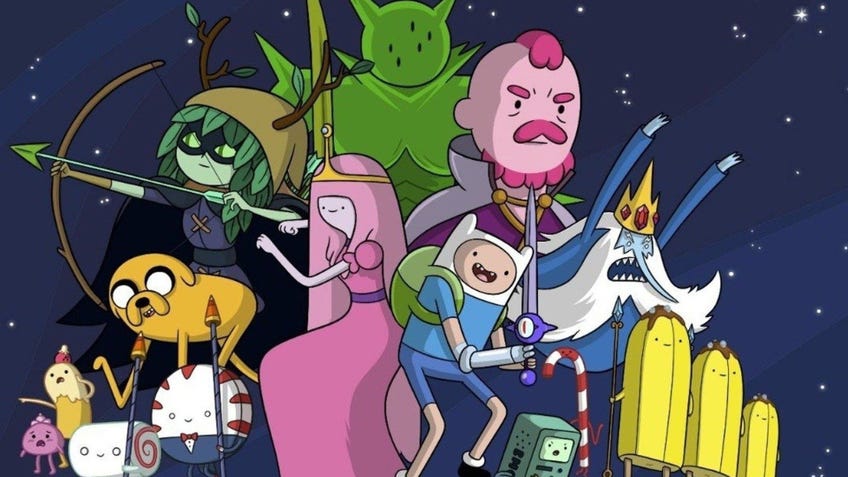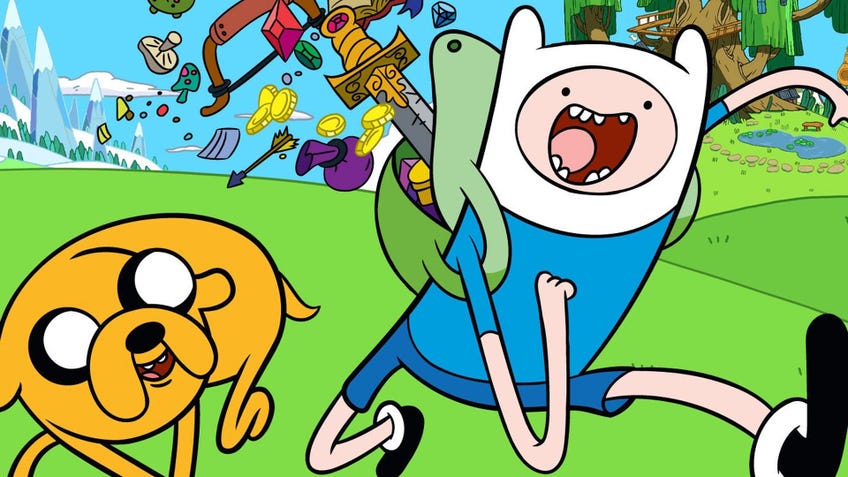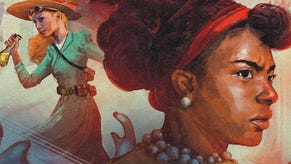Here’s how the Adventure Time RPG’s new Yes And system works
Come on, grab your dice.
An Adventure Time RPG is on the way, opening up the beloved Cartoon Network show’s land of Ooo - home to Jake the dog and Finn the human - for players’ own whimsical quests.
Rather than being powered by an existing system such as Dungeons & Dragons 5E - although the game will be converted to support D&D 5E’s rules via a separate zine - the Adventure Time RPG will be the first game to run on the new Yes And ruleset.
Using a pool of custom dice, the system aims to be a beginner-friendly introduction to tabletop roleplaying that favours narrative flexibility and creativity, embracing Adventure Time’s anything-goes approach to storytelling while providing enough structure to support its players.
Ahead of a planned Kickstarter campaign later this summer, Dicebreaker caught up with Adventure Time RPG's creative director Matt Fantastic to find out more about how the upcoming game’s Yes And system will work.

In contrast to the iconic d20 of D&D or the multiple polyhedral dice of many modern RPGs, the Yes And system relies on a simple pool of custom six-sided dice. (A planned starter set will include the dice.)
During a typical skill test - for instance, when trying to climb something or fight an enemy - the player rolls two dice. One is a die marked with Yes and No on different faces, with the number of Yeses and Noes depending on the difficulty of the test and the character’s proficiency in a particular skill. There are five multi-coloured dice, increasing from the most difficult red die - with a single Yes result - to the much more forgiving purple die, which has just a single No.
The Yes/No die is combined with a black And/But die, which has three possible results: And, But or a blank face. The black die judges the level of success or failure of the character, potentially modifying the “Yes” or “No” outcome of a test with an “And…” or “But…”
The system aims to eliminate the “the prisoner behind a locked door problem” in games such as D&D, where a failed roll can bring the story to a sudden halt.
Fantastic says that the rules-light system is designed to keep players engaged with the story happening in the world without pulling them too far out into the maths and rules-checking of the gameplay.
“In something like a D&D, you have a narrative component. Like, ‘I want to jump over this chasm’ or whatever,’” the designer explains. “Great. Now, switch to some numbers, roll some dice, checks and stuff. You got a 14. Okay, so now we shift back to the narrative from that sort of really abstract resolution mechanic and I'm going to narrate if you do or don't jump across that chasm.
“With Yes And, it stays narrative the whole time. ‘I want to jump across this chasm.’ I check a couple things to know exactly what I roll. Boom, I roll these two dice. It says ‘Yes, But…’ Now I just stay in that; ‘Jump across the chasm? Yes, you make it across, but then you kind of slip and you drop your bag into the chasm.’ So it stays in that narrative space the whole time.”
The system also aims to eliminate what Fantastic calls “the prisoner behind a locked door problem” in games such as D&D, where a failed roll - such as failing to pick the lock on a crucial door - can bring the story to a sudden halt. Adventure RPG’s GM player - currently known as the Grayble Teller, though that may change before its final release - can allow players to roll only the And/But die, guaranteeing a success - albeit with a possible complication that still allows them to “fail forward”. (The Grayble Teller themself almost never rolls dice, leaving the characters to react to their narration and described events, as well as determining their own success.)
“Especially in Adventure Time where there's such weird power levels and all this kind of stuff, at the end of the day, Jake and Marceline can kind of do anything, right? And the Ice King can kind of do anything. But it's like, how well do you do it?” Fantastic says.
“You're gonna get through this door; you have to get through this door to continue this story. We know you're going to do it. The question is: does the guard show up while you're doing it? Do you secretly sneakily do it and nobody notices? Do you hurt yourself or damage something? We can still make it an interesting narrative situation, even if we're pushing you through and the risk of failure isn't necessarily there. Whereas a D&D-type system is the opposite; it's success/failure. There's not this built-in way to fail forward or to continue propelling the story if you hit that sort of brick wall, narratively.”

While the Adventure Time RPG’s gameplay will typically be more forgiving and looser than many traditional RPGs, there will still be room for players to build their own characters around specific attributes and skills. (The rulebook will also allow newcomers to jump right in as pre-made characters like Finn, Jake and Princess Bubblegum to help them learn how to play as a familiar face before creating their own character.)
The game has four core stats - Physical, Mental, Social and Talent - that influence which dice they roll for a certain test, adjusting the chosen die up or down depending on the difficulty and the character’s level in the trait, from amateur to master. Talent is a broader catch-all attribute that represents a character’s unique skills - whether that’s magic or conversing with robots. Even then, the game won’t restrict players to using specific skills in certain situations.
“You're really encouraged to, narratively, convince me why you should be able to use a better stat,” Fantastic explains. “Which does two things; one, it really engages people in that story, and makes them think about their character. And then, two, it drives that narrative forward in ways that make sense for that character. How is BMO going to make it to the top of this cliff? It's not going to be climbing, because BMO has a bad physical stat. So how do I narratively make it so that BMO gets to use a different stat? It could be that there’s like a snake over here and BMO is going to convince that snake to carry him up the cliff [using Social], or whatever it is. It encourages you to tell a story with your character and to inhabit that character.”

In place of the varied skills and feats of games like D&D, the Adventure Time RPG similarly fleshes out characters with abilities, currently labelled under the friendly term “Things You Can Do”. These skills add what Fantastic describes as “fuzz” to the world and story, giving each character a more distinct personality and talents without weighing things down with endless extra rules and effects.
“Some of the stuff is a little bit more specific; so if you spend 10 minutes giving a speech to everybody, you hype them up, and then everyone gets an advantage on the next thing they do. That's more discrete,” they say. “And then you have other stuff where BMO has ‘a thing you can do: skateboarding,’ and then it says: ‘can move really fast and do cool stunts’".
In a complicated, crunchy system it's like, ‘I took the skateboarding feat and the skateboarding feat means I can move 60 feet in a round and then I can roll an athletics check to do a trick.’ Whereas here, it's just: 'BMO can skateboard.'
“In a complicated, crunchy system it's like, ‘Oh, I took the skateboarding feat and the skateboarding feat means I can move 60 feet in a round and then I can roll an athletics check to do a trick.’ What does that mean? Whereas [here], you're still you're still having that experience. It's just: 'BMO can skateboard.' Like, of course. Duh.
“For us, it's hitting that sweet spot between there's things you can do - there's this abstraction and degree of what are the things that we're checking - but it's like, yeah, BMO can skateboard. We don't need to say BMO gets a +4 to skateboarding check, or whatever. That’s not enhancing the story that we're trying to tell where BMO's skateboarding and doing a stunt across the chasm.”
These abilities will provide the RPG’s sense of progression and specialisation, as players advance along talent trees based on the things they can do. That advancement might see a character go from hovering, to flying, to flying really fast, or picking up new spells as they study magic.
Some abilities will depend on the character - for example, robots and elemental creatures will have different distinct powers available to pick from - while others will grant universal skills open to any character. Gaining new abilities in a certain category related to one of the four core skills will then see that attribute improve, allowing characters that gain physical skills to become more capable in general physical tasks, for instance.
Weird junk represents the weirdness of Ooo and the world that you're in.
Other talents will be granted by equipment found on your adventures, with a sword opening up the chance for a character to gain other swordfighting skills - even if they’re not especially great at it at first. Alongside equipment that carries between sessions, characters will be able to discover ‘weird junk’ - stranger, often more powerful items gained at the start of a session by rolling on a table that are usually only held onto during a single adventure, and disappear after they’re used.
“That represents the weirdness of Ooo and the world that you're in,” Fantastic says. “Watching the show, there's just little bits and pieces, all kinds of stuff all over the place. You might get a mug of hot cocoa, you might get a stick, you might have whatever it is, and then that goes away at the next adventure. So all session until I use it up or break it or do whatever, I have this stick. And what do you do with a stick? I mean, whatever you want. It's stuff that doesn't have inherent abilities. It's not like this stick is a +2 Stabbing Stick or whatever. It's just a stick.
“Then there's some stuff where it's totally open, where you have weird goo. And it's like, okay, well, you tell me what that weird goo does. Within reason; it's not "Oh, I throw this and it melts the world." But is it a sticky goo? Is it a poisony goo? You can tell us what you want it to be.”

Like the rest of the game, these items and equipment won’t be tied to specific numbers and effects. When combat does occur, it’s kept as simple and flexible as other tests. Foes can be weaker chumps - requiring just a single success during a roll to defeat - or tougher Big Bads, which will require a specific number of successes to defeat, as well as other effects. Those successes don’t have to be specific combat attacks; it might be that Finn hits a baddie with his sword, or BMO instead talks an enemy out of fighting.
During fights, the players roll at the start of each round to see whether they take their “action time” before or after the Grayle Teller - a looser approach to initiative than the likes of D&D’s fixed turn order. With the group acting at once, they have the option to easily work together - BMO could duck down behind an enemy, before Finn pushes them over. There’s no need to manage specific action types or timings - and like the rest of the game, players can try and talk the GM around to allowing whatever trait or skill they want to use.
“Ultimately, ‘We're doing a thing together’ is really possible now - and it's not that you go, then you go, then you go. It's ‘[Multiple] of us have a thing that we want to do together and we're going to resolve that together,’” Fantastic says. “It opens up a lot more narrative possibilities for how you do some of the stuff that you're trying to do.”

In keeping with the TV show’s short and sweet episodes - which only last around 10 minutes or so - the tabletop RPG will cater to compact sessions and campaigns, advancing players’ characters quickly. If you want to run a longer ongoing adventure with the same group, you’ll still have that option, though.
“We're absolutely going to have it there so that you can play for two years and run this huge thing and start nowhere and then end up galaxy-spanning craziness,” Fantastic says. “But every session you're going to be advancing. Every session, you're gonna get a new thing you can do, and you can get better at a thing you already do.”
The Adventure Time RPG will be the first game to run on the Yes And system, but Fantastic hopes to make use of the beginner-friendly ruleset in other games in the future. When it comes to its debut, though, they say it couldn’t be a better fit.
“The goal is to be able to apply the core [Yes And] system to a bunch of different stuff. But it is great that Adventure Time is the first because a) we all love Adventure Time, but also because, as a world, it is inherently loose and weird.”



